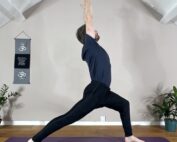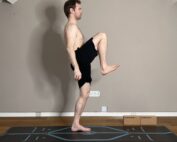
How to Do Wild Thing Pose (Camatkarasana)
Welcome to Dav Jones Yoga guide on Wild Thing Pose! I’m Dav Jones, and I’m here to support you in your yoga journey by offering insights into the practice of yoga, regardless of your level of experience. In this blog, I’ll guide you on how to do Wild Thing Pose (Camatkarasana) safely and its benefits. If you want to grow in your yoga asana practice, you’re in the right place.
Understanding the Wild Thing Pose
Wild Thing Pose, known as the Camatkarasana, is a posture that combines an arm balance and a backbend. This pose provides an opening for the chest area and hip flexor region of the body by expressing its shape by arching the body. By engaging in this yoga asana, Wild Thing Pose can bring flexibility to the spine and build strength in the hips and abdominals.
Wild Thing Pose (Camatkarasana) Basics:
- Sanskrit: Camatkarasana
- Pronunciation: Cam-at-kar-a-sana
- Meaning: The pose that embodies the joy and freedom of the wild, enhances the opening of the heart area.
Warm-Up Poses for Wild Thing Pose
Before attempting the Wild Thing Pose, it’s essential to warm up the body properly to limit the chances of injury. Here are some recommended warm-up postures:
Wrist stretches & warm-up

Wrist stretches & warm-up

Cobra Pose (Bhujangasana)

Cat Pose (Marjaryasana)

Parighasana (Gate Pose)

Cow Pose (Bitilasana)

Side Plank (Vasisthasana)
How to do Wild Thing Pose?
The Wild-Thing pose is a fun and energising yoga pose that opens up the chest, shoulders, and hips while strengthening the arms, shoulders, and back. Here’s a step-by-step guide on how to perform the Wild Thing Pose:
Step 1. Foundation and Entry

- Begin in Downward Facing Dog. Focus on grounding your hands and spreading your fingers to distribute your weight evenly.
- Breathe steadily, preparing your mind and body for the transition.
Step 2. Step to the top of the mat for Low Lunge

- Step your right leg forward to the top of the mat for Low Lunge.
Step 3. Pivot all ten toes into Mandala Pose – Preparation for Side Plank.

- Pivot all ten toes to the right.
- Heel-toe the front foot halfway down the mat for Mandala Pose.
- Raise the right arm and look up.
Step 4. Transition into Side Plank (Vasisthasana)

- Step the front onto the rear foot for Side Plank.
- Turn the fingers of the grounded arm outwards and push through the heel of the hand.
- Press the inside-edge of the bottom foot (big toe/inner heel area) into the mat.
- Lift the bottom hip upwards.
Step 5. Step behind for Wild-Thing Pose

- Slowly step the top foot behind you.
- Root down through the inner edge of the left foot
- Lift hips upwards and spiral chest towards the ceiling/sky
- Gently ease the body in the direction of the opposite long-edge of the yoga mat – this brings a gorgeous stretch into the lateral side of the body.
Step 6. Holding the Pose
- Maintain the pose for several breaths. With each inhalation, try to expand your chest and open your heart area more.
- With each exhalation, try to deepen the backbend and increase your comfort level in the pose.
Step 7. Carefully exit the pose
- To exit the pose, slowly reverse the steps. Bring your right hand back first, followed by your foot, and return to Downward Facing Dog.
Benefits of Wild Thing Pose (Camatkarasana)
Modification And Props For Wild Thing Pose
- Practise the preparatory poses mentioned above. Especially Parighasana (Gate Pose) and Side Plank (Vasisthasana).
- Practice getting stronger in holding Plank Pose and Forearm Plank Pose.
Safety and Precautions
- Avoid this pose if you have carpal tunnel syndrome or are currently experiencing high blood pressure or a headache.
- Be cautious if you have shoulder or neck injuries.
- Always perform this pose with a warmed-up body to avoid strains.
- Do not attempt this pose without proper supervision if you are new to yoga or unfamiliar with backbends.
Final Thought
We’ve explored Wild Thing Pose, highlighting its steps and benefits for enhancing your yoga asana practice. If you’re interested in deepening your practice, consider joining the Dav Jones online yoga classes on Patreon. If you’re looking for a more tailored/specific approach to your practice, then take a look at the Dav Jones Yoga mentorship program.









